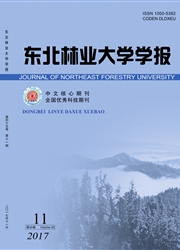

 中文摘要:
中文摘要:
研究了辽东山区蒙古栎(Quercus mongolica)、杂木林、胡桃揪(Juglans mandshurica)3种次生林群落土壤转化酶、淀粉酶、脱氢酶和过氧化氢酶活性的季节变化规律。结果表明:次生林群落土壤酶活性均呈明显的垂直分布特性,即随土壤深度的增加,酶活性逐渐降低。次生林群落土壤酶活性具有明显的季节变化特点,不同群落酶活性变化趋势不同,其中蒙古栎林的土壤转化酶、淀粉酶和脱氢酶活性最高,胡桃楸林最低,但胡桃楸林过氧化氢酶活性相对最大。4种酶活性在不同群落间差异均达到显著水平(P〈0.05),这可能与植被类型、凋落物的多样性或植物根系分泌物的不同有关。
 英文摘要:
英文摘要:
An experiment was conducted to study the seasonal changes of soil enzyme activities in three major forest types (Mangolian oak forest, broad-leaved mixed forest and Juglans mandshurica forest) in the mountainous regions of eastern Liaoning Province. Resuhs sbewed that soil enzyme activities exhibited a vertical distribution, namely enzyme activities decreased with increasing soil depth. An obvious seasonal change in soil enzyme activities was also observed, and the changing tendencies of enzymes in different forests were various. The activities of invertase, amylase and dehydrogenase were highest in Mongolian oak forest and lowest in J. mandshurica forest, but the relative activity of catalase in J. mandshurica forest was the highest. The difference in enzyme activity between different forests reached a significant level, which implied that the enzyme activity was related to vegetation type, litterfall and plant root secretion.
 同期刊论文项目
同期刊论文项目
 同项目期刊论文
同项目期刊论文
 期刊信息
期刊信息
